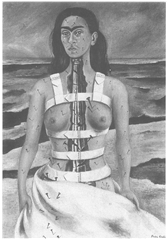 December 9, 2012
December 9, 2012Frida Kahlo (1907-1954), "Broken Column" (1944)
As I approach age 77, I have begun to think of myself as an amateur intellectual historian. This year, I have written ten (10) journals, ranging in size from 120150 pages each. They have titles like "Bookshop Journal," "Bike Journal," "Publishing Journal" "Occupy Journal," "The Co-op Journal," "Woman's Journal," "Spiritual Journal." My latest is "Sex Journal."
As an intellectual historian, one of my greatest interests, perhaps the greatest after peace-and-justice, has been Feminist Art. Perhaps the most famous feminist artist of all time, next to Georgia O'Keefe of course, is Frida Kahlo. Yet I have never "investigated" ("studied," "thought of") her as a feminist artist. This morning (and it really is morning: 4 a.m.) I'm asking, "What is particularly feminist about Frida Kahlo?" To help me answer that question, I've read
Liza Blakewell's "Frida
Kahlo: A Contemporary Feminist Reading," in Frontiers, A Journal of Woman's Studies.
I spent a year in Mexico (1959), where I had gone to put together an Anthology of Contemporary Mexican Poetry for my new poetry press.And I agree with Liza Blakewell that Frida must be understood in the background of mestizaje, whose most visible figure was Jose Vasconcelos and his "raza cosmica." It must also be remembered that her father, Wilhelm Kahlo, was a Hungarian Jew who emigrated to Mexico in 1892; Frida was Mexican, but she, like Mexico itself, was a hybrid of Europe.
In 1929, Frida married the most visible artist of mestizaje and the new revolutionary self-conscious nationalism and indigenista of his country, Diego Rivera. When I took classes at The New School in New York, the entire dining room was covered with original murals of Orozco, so one can see Frida's background, in part, in the Mexican mural genre; however, there were no women muralists.
In my "Woman's Journal," I disclose an unusual feature of gender difference between men and women in the workplace that has great relevance for seeing Frida as a feminist I realize. In the workplace, when there is conflict and problem, men are able to resolve and reconcile half the time; they do this quickly, if not well. Women, on the other hand, are able to resolve and reconcile less than half as often as men, and they do so slowly. The feminist study in which I read this report explained that, for me, the question was how to "get on with the job" as quickly and efficiently as possible, even if it meant a less than sincere overlooking the problems. But for women, the relationships were more important than the job, and they wanted problems between people looked into deeply and well.
How does this apply to Frida? Well, the Mexican Revolution that her husband was the artistic leader of had immense contradictions and betrayals, huge problems, problems that resulted in the October 2, 1968 government massacre of hundreds of peaceful citizen protesters in Mexico City for example. For Diego Rivera and the other male artists, these contradictions were quickly glossed over. But for Frida, the Mexican Revolution included its contradictions, and she refused to gloss over them because they highlighted relationships interesting to her as a woman and an artist, or so I think. Bakewell even sees Frida combining male and female within individuals in her art, as she embraced everything puzzling and problematic, a great feminist characteristic (at least, one outside of Academia). Frida was a cultural cross-dresser!
Frida was also a social cross-dresser and cross-dressed in her paintings. She posed for a photograph, with her family, dressed as a man, as a protest of "woman's place." She paints herself in male clothing of her time and place. She cut off her hair (a protest against "female beauty"). She would paint a moustache on her self-portraits and exaggerate manish facial hairs, gender-blending and sexually ambiguous to say the least. Mexican women were repeatedly told to stay out of the political realm, but Frida continuously violated this spoken and unspoken prohibition.
Finally, Frida fashioned a feminist identity for herself, ingeniously and originally. In Mexico of her time, a woman could gain recognition in mainly three ways: in religion, on the stage, and in her marriage. Well, Friday married well, from the point of view of recognition (Diego Rivera). And her home, her life, and her paintings are replete with religious iconography. Although she did not do a lot of stage, she did do a lot of staging, as she was primarily a self-portraitist of what today would be called "the Cindry Sherman kind," of so I believe. Finally, as Octavio Paz has pointed out, Frida was feminist by virtue of her deliberate sexual ambiguity, an original protest in that place at that time.

No comments:
Post a Comment